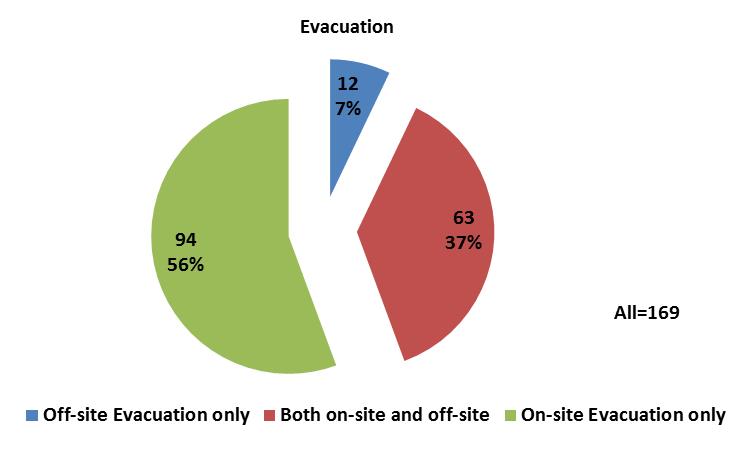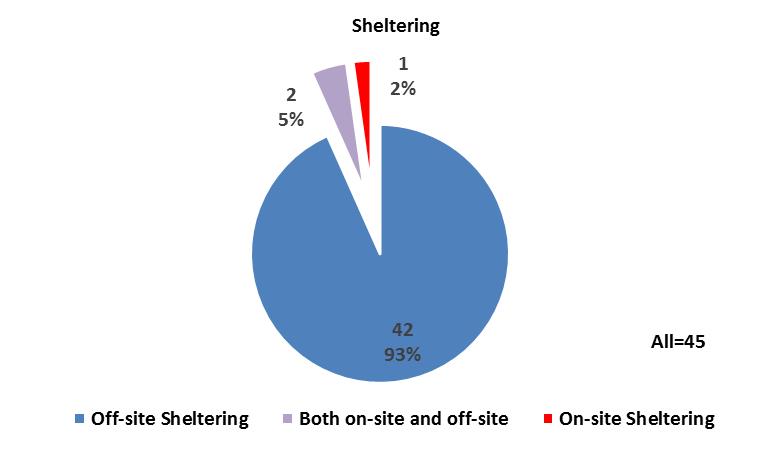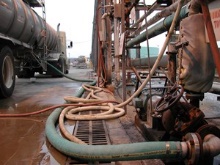Lessons Learned Bulletin No. 10
December 2016
JRC 105148
pdf version (en) ER1 Leerpunten van incidentbestrijding – Evacuatie en schuilen (nl)
Return to Lessons Learned Home Page
Chemical Accident Prevention & Preparedness
Learning from emergency response – evacuation and sheltering
The aim of the bulletin is to provide insights on lessons learned from accident reported in the European Major Accident Reporting System (eMARS) and other accident sources for both industry operators and government regulators. In future the CAPP Lessons Learned Bulletin will be produced on a semi-annual basis. Each issue of the Bulletin will focus on a particular theme.
Emergency response
The currentissue is the first part of a series of lessons learnedfrom research on emergency response. In particular, it discusses lessons learned from evacuation, sheltering, containment and accidents involving spectators. The second part will address lessons from emergency response involving firefighters, meanwhile the third and last part will describe learning from emergency response in general.
Please note:
The accident descriptions and lessons learned are reconstructed from accident reports submitted to the EU’s Major Accident Reporting System
https://emars.jrc.ec.europa.eu
as well as other open sources. EMARS consists of over 1000 reports of chemical accidents contributed by EU Member States and OECD Countries.
The cases selected for this bulletin also generated a number of lessons learned, not all of which are detailed in this bulletin. The bulletin highlights those lessons learned that the authors consider of most interest for this topic, with the limitation that full details of the accident are often not available and the lessons learned are based on what can be deduced from the description provided. The authors thank the country representatives who provided advice to improve the descriptions of the cases selected.
|
Accident 1
Containment and spectator control
Sequences of the event
An explosion and fire occurred in a glue factory. The substances involved in the ignition were solvents (toluene and xylene), PVC and finished products (polyurethane mastic and glues). A technician had been filling a 25-litre metal bucket from a 1,000-litre container of solvent using an explosion-proof pump and an antistatic plastic hose, which in touching the side of the bucket caused a spark to ignite the liquid. The technician alerted his colleagues, who responded with extinguishers, but by that time the fire had spread to the container and quickly developed into a blaze. Since the fire door between the central workshop and solvent storage room had remained open, flames entered the workshop and destroyed it along with the stock of finished products, packaging supplies and admixtures. Since atmospheric conditions were unfavorable for the plume to rise and disperse, rescue services asked residents to remain indoors; 3 schools were evacuated.
Causes
It seems that the operator mistakenly filled the reaction vessel with a mixture of monomers containing more DCPD than required. The presence of an excess content ratio of DCPD led to a runaway reaction.
|
Important findings
• The event was subjected to heavy media coverage through the broadcast on local radios of the orders to remain indoors, information which was re-broadcast on national radio stations.
• Several press organisations arrived even before structures had been created to gather and coordinate reliable facts about the event and consequences that not been taken into account in the risk studies.
• The fire door between the central workshop and solvent storage room had remained open, therefore the fire could spread across the workshop and destroyed it.
Lessons Learned
• The fire door was left open which gave free access to the fire to spread across the workshop. Operational procedures should be followed all the time, emergency refreshment trainings are necessary to remind workers to these procedures. Also, an emergency exercise could have revealed this problem. It is likely that the door had been remained open even before the event.
• It is important to note, that the presence of the media can cause extra workload and stress for emergency responders. Such situation creates a strong pressure of information demand on all those involved in the emergency response operations. Therefore, it is advised to set up a media information center that could provide the latest news about the emergency situation in an organized way.
[EMARS Accident #399 and ARIA 19385]
|
Emergency response - Evacuation and Sheltering
As part of both the internal (on-site) and external (off-site) emergency plan, in case of an accident involving dangerous substances, mitigation of the exposure to dangerous chemicals could occur mainly by means of evacuation, shelter-in-place and containment of the incident such that its area of impact is greatly restricted.
Evacuation is when people are moved away from the effects of the accident, leading them towards an assembly point/centre or other designated areas (schools, public areas etc.). Both on-site and off-site evacuation procedures can be successful if they are planned prior to any accidents occur. Evacuation procedures are normally written in the emergency plan and the emergency procedures.
Sheltering is a response intended to protect people from possible exposure by requiring them to stay indoors (e.g., at home or public areas such as offices, schools etc.). In 45 accidents sheltering was cited in the report as having been launched. Of these, there were 22 cases with specific details reporting about the evacuation, i.e., the plant employees were evacuated and/or citizens were ordered to stay indoors either because of the toxic dose measured or simply as a precautionary measure. In the other 23 cases on-site personnel was not evacuated or not known, in these cases only off-site sheltering was required for the population in the vicinity of the establishment. Figure 2 below shows that the vast majority of cases consisted of off-site sheltering and only a small portion of cases involved on-site sheltering.
As Lees (Lees, 2012) summarised, “… principal mitigating features are shelter and escape. Escape may be by personal initiative or by pre planned evacuation. It should not be assumed that emergency measures are synonymous with evacuation. A combination of evacuation, shelter-in-place as well as other measures may be taken based on the event as well as preplanning evaluations. For releases of flammable substances, evacuation of non-emergency personnel is always beneficial and leads to reduction of casualties. On the other hand, for toxic releases, the emergency instructions may be to evacuate the area but are more likely to be to stay indoors and seal the house. Emergency measures may be of great value in reducing the toll of casualties from a major incident. For an explosion that gives no advance warning, there is no time for emergency measures such as evacuation. This does not mean, however, that evacuation has no role to play as far as fire and explosion are concerned. On the contrary, although the initial event may be sudden, there are frequently further fire and explosion hazards. Evacuation may then be applicable.”
Out of the 753 accident reports in 169 cases evacuation actions were reported[1]. Figure 1 presents the distribution of on-site and off-site evacuations; in 56% of the reported cases (94 reports) only on-site evacuation; in 7% (12 cases) of the accidents off-site evacuation was required. In 63 cases (37%) both on-site and off-site evacuations were necessary. Even if the number of reports with evacuations required (168 reports) appears to be proportionally small compared to the number of overall 800+ cases, it is important to note, that not all accidents result in the necessity of evacuation. For example, in accidents where the loss of containment was stopped or reduced significantly immediately after the release; or in other cases, where the fire was extinguished shortly after it broke out or the part of the unit affected by the accident was very limited; or for example, in closed buildings where the event did escalate and it did not have any effects on workers. In other cases, especially in explosions, emergency response could not be performed because the explosion is rapid and the consequences are immediate and no mitigating measures can be taken. Also, in cases where environmental pollution occurred as a result of the loss of containment event, the operator realised the release too late to be able to take any protection measures against the environmental impact.
 |
 |
| Figure 1: Evacuation in the reported accidents (Source: eMARS) |
Figure 2: On-site/off-site sheltering and their combination
(Source: eMARS) |
Containment refers to a mitigation strategy in which mechanisms are in place or activated to prevent a dangerous phenomenon (fire, explosion or toxic release) from spreading. Containment strategies may be active or passive. For example, active containment involving application of foam, powders, gases, and coolants may be used not only to extinguish a fire but also to prevent fires and toxic releases from spreading to nearby people, equipment and installations, and to reduce the risk of escalation. Passive containment measures include water curtains, fire-rated walls and doors, insulation, blast resistant structures, compartmentalization and secondary-containment (bunds). Statistics did not cover eMARS reports that involved containment mechanisms, because they have a more complex profile than evacuation or sheltering, but some case studies were extracted where the incident containment strategy was clearly a factor.
_____________________________________________________________________________________________________________________
1Within the current analysis, on-site evacuation means employees and other workers (contractors, office workers) within the company affected by the accident, off-site evacuation means evacuation of workers from the neighbouring facilities and the public; in other words, everybody outside the premises of the affected company who are not involved in the emergency response.
Accident 2
On-site evacuation
Sequence of events
A leak in a pipeline caused the release of hydrogen fluoride in a compartment of a process building. Alarm was given, the process was shut down. By shutting down the pulsation and keeping the extraction of air, the ventilation system created an under pressure. The ventilated air was sent to a scrubber. The building was evacuated. Two contractors, doing a painting job in this compartment, were directly affected. When they left the compartment, some hydrogen fluoride spread into a passage way, which served as an air lock. When the building was evacuated, 12 other contractors passed through the air lock, and were possibly exposed to hydrogen fluoride. In total, 14 people (all third parties doing maintenance work) were brought to the hospital 30 minutes after the exposure.
Important findings
• During evacuation 12 contract workers passed through an air lock that was contaminated with hydrogen fluoride when the door of the affected compartment to this air lock was opened by the escaping workers in it.
• It seems that the emergency response procedures did not consider the release of hydrogen fluoride from the pipeline as a possible accident scenario.
• Furthermore, evacuation procedures did not take into account the risk of people being exposed to dangerous substances while using the escape route.
Lessons learned
• In preparing emergency plans, the possible accidents should be assessed independently from their high or very low probability. An evacuation plan should be drawn based on the identified accident scenarios.
• When preparing an evacuation plan, all designated escape routes and emergency exits should be checked that they are easily accessible and visible. The air condition system should not carry smoke or toxic fume resulted from the accident to the escape route.
[EMARS Accident #22]
Accident 3
Exposure prevention, incident containment
and off-site evacuation
Sequence of events
A major leak of hydrogen fluoride (HF) occurred at a chemical factory. Five workers were killed and 18 affected. Two workers were on the top of a tanker containing HF. They were preparing to connect a flexible air hose to a valve on the tanker top in order to offload it to the plant by pressurisation. While they were working with connections on the tanker, about eight tonnes of HF erupted at high pressure from the tanker and rapidly spread to the surrounding atmosphere.
|
The two workers were engulfed in the fumes, thrown from the top of the tanker and killed. Two other workers repairing a pump at ground level near the tanker were also killed. And one working at plant reactor was killed. Another eighteen workers were injured or affected by HF fumes. There were large- scale effects on the surrounding area, widespread damage to crops and livestock. Hundreds of local residents, within 3,000 metres of the incident, were evacuated from their homes.
Important findings
• One of the operators tripped on a valve and a leak started.
• The two workers who attempted to connect the tanker to the plant can be clearly seen on the video footage working on the tanker connections without any respiratory or full body protection. (It is considered unlikely that they thought that the tanker was empty and did not pose a risk).
• Municipal firefighters arrived at the scene without knowing the exact nature of the accident and without adequate protection (mask and acid suit). They deluged the leak with water, thus worsening the product release.
• The response of the authorities was considered slow and inadequate. The 300 residents directly affected were not evacuated until 10 days after the accident and it appears that insufficient resources were available forthe emergency response. In particular, neutralizing agents (lime) were not available during the first 22 intervention hours.
Lessons learned
• Working with hydrogen fluoride requires certain personal protection equipment, such as gloves and respiratory protection.
• Any establishment that handles very toxic materials should draw up emergency plans. In preparing such plans, the possible major accidents should be assessed. Based on the identified accident scenarios, appropriate resources and competence should be immediately available including appropriate hazardous materials response equipment.
• An external emergency plan should also be in place that outlines critical time frames for decision-making taking into account potential accident scenarios. The authority in charge of response coordination, the individual with the power to take decisions, coordination with other responder teams, and protocols for dealing with accident uncertainties and unforeseen circumstances should all be clearly defined.
• Nearby residents at risk from a potential accident should be routinely kept up to date about the establishment’s dangerous activities and how they will be informed should an event occur. The external emergency plan should foresee timely information to the public about an event that has occurred and what they should do to minimise harm to themselves and others.
[EMARS Accident #1009]
|
Accident 4
On-site evacuation and exposure mitigation
Sequence of events
On January 16, 2002, highly toxic hydrogen sulphide (H2S) gas leaked from a sewer manway at the Georgia-Pacific Naheola mill in Pennington, Alabama. Several people working near the manway were exposed to the gas. Two contract workers were killed and eight were injured. All of them were transported to hospitals reporting symptoms of hydrogen sulphide exposure. Apparently, NaSH from the tank truck unloading station was released to the acid sewer, where it inadvertently reacted with sulphuric acid to produce H2S.

Figure 3: The truck loading and the collection drain (Source: CSB)
Important findings
• The written procedures did not list NaSH or other substances that collected in the oil pit and could enter the acid sewer.
• H2S was not identified as a hazard in the immediate area of the mill where the accident occurred. For this reason, there were no monitors, alarms, or warning signs in the area.
• The company did not require detailed H2S safety training for those working in this area of the mill. The contractors working on the day of the accident had only a basic awareness of H2S and its hazards.
• Interviewed employees had observed leaking chlorine dioxide from the fiberglass manway on previous occasions and recalled repairs that were sometimes documented by work orders. These events were not reported as near-miss incidents, nor were the causes of the leaks formally investigated.
• The injured contract workers assisted each other and carried their fatally injured co-workers from the area closest to the release and they were taken to the mill first-aid station prior to setup of the incident command system. They were not decontaminated at the scene. Mill guidelines did not provide for decontamination at the first-aid station.
• The six paramedics who evacuated the men from the mill first-aid station reported symptoms consistent with H2S exposure.
Lessons learned
• Providing training to employees and contract workers on the hazards of dangerous substances present in the immediate work area, and appropriate emergency response practices are crucial.
|
(How they should behave in case of potential emergencies on other areas of the site should also be detailed.)
• The company should investigate near misses and take appropriate corrective actions as soon as possible to avoid a future event. Procedures and the safety management system should be updated to reflect the lessons learned, including their implications for emergency planning. Near misses should be proactively communicated to staff as a part of routine training and awareness measures.Ambulance and hospitals should be informed as soon as possible about the substance to which the injured people were exposed in order to provide effective and immediateassistance. Decontamination of responders should be foreseen in the emergency plan and executed without delay where contamination can be reasonably suspected.
[http://www.csb.gov/mobileemergency-response-investigations/]
Accident 5
Sheltering
Sequence of events
A fire involving sodium dichloro-isocyanurate associated with the release of chlorine and chlorine compounds, caused the formation of a toxic cloud affecting neighbouring urban areas. The on-site emergency plan was activated. An attempt was made to control the fire with on-site extinguishing equipment, but eventually external assistance was also requested. The off-site emergency plan was activated and the population was sheltered-in-place as a protective measure. Initially the smoke cloud moved towards the two nearest municipalities, later the wind direction changed. For this reason, other nearby municipalities, which could also have been affected by the cloud, were informed about the occurrence and were requested to alert the population to immediately take shelter. The total size of the population sheltered came to approximately 20,000 inhabitants.
Important findings
•The post-accident evaluation discovered that the off-site emergency plan did not consider the scenario of a fire with smoke containing a certain percentage of chlorine. Yet scenarios of accidents caused by the release of chlorine and the formation of a toxic cloud were considered. These accident scenarios foresaw much more serious consequences than those of the actual accident.
•The fact that the population living in the vicinity was alerted and requested to take shelter in their homes and to close doors and windows contributed to reducing the consequences of the event.
Lessons learned
•Emergency services should possess up-to-date information about the weather conditions to ensure that people outside the establishment are not affected by the toxic plume.
•In those cases where the population is ordered to shelter, emergency services are responsible for continuously monitoring the concentration of the toxic cloud. In case the wind direction changes, the population might be affected by this change should be informed instantly.
[EMARS Accident #264]
|
Motto of the semester
______________________
“Salus Populi Est
Suprema Lex”
“The health of the people is the supreme law”
Cicero
MAHBulletin
ContACt
For more information related to this bulletin on lessons learned from major industrial accidents, please contact
zsuzsanna.gyenes@jrc.ec.europa.eu or emars@jrc.ec.europa.eu
Technology Innovation in Security Unit
European Commission
Joint Research Centre
Directorate E - Space, Security
and Migration
Via E. Fermi, 2749
21027 Ispra (VA) Italy
https://minerva.jrc.ec.europa.eu
If your organisation is not already receiving the MAHBulletin, please contact emars@jrc.ec.europa.eu. Please include your name and email address of your organisation’s focal point for the bulletin.
All MAHB publications can be found at Minerva Portal

|
Checklist on emergency response relating to
evacuation, sheltering, and containment
• Is there an internal emergency plan and has it prepared in relation to the needs associated with all the site’s credible accident scenarios, of both high and low frequency?
• Are there any evacuation procedures established with clear roles and responsibilities?
• Are third party workers and visitors briefed about the surrounding hazards and the emergency procedure when they start work/arrive at the site? Are training, signageand other communication adequate to maintain worker awareness on what to do and where to go in case of emergencies?
• Do employees know about the passive containment measures (e.g., fire doors) and how to recognise situations that compromise their functionality?
• Are employees, third party workers and visitors informed about the emergency via audible alarm or siren? Are those systems tested regularly?
• Is there a first-aid station in place and are employees trained to provide first-aid in case of an emergency?
• Does the operator make sure that for workers who have roles in the emergency response have adequate personal protection equipment available?
• In case of evacuation, is anyone appointed for making sure that all workers and others in the workplace, for example contractors, customers and visitors are accounted for?
• Has an external emergency plan been drawn up in case of emergencies that have off-site effects? If so, are there evacuation and sheltering procedures included in these plans? Are these external plans regularly reviewed, tested and if necessary, updated?
• Do such external emergency plans cover all possible accident scenarios, even those with low frequency?
• In case of off-site evacuation is the mobility of people, elderly people and disabled persons considered in the procedure and prepared/tested for?
• Do emergency responders have a site map that illustrates the location of fire protection equipment, emergency exits and assembly points?
• What means of communication are available on-site for effective coordination between the on-site and off-site emergency teams? Have they been tested in joint exercises to evaluate their effectiveness and identify improvements?
• Does the external emergency plan clearly define the authority in charge of responsecoordination, the individual with the power to take decisions, coordination with other responder teams, and protocols for dealing with accident uncertainties and unforeseen circumstances?
• Do emergency plans make provisions for dealing with spectators and the media in order to prevent them getting in the way of the response effort or being harmed?
• Are there any arrangements for providing the public and any neighbouring establishments or sites that fall outside the scope of this Directive in accordance with Seveso Directive (2012/18/EU) Article 9 with specific information relating to the accident and the behaviour which should be adopted?
• Are there any measures for receiving early warning of incidents, and alert and call-out procedures?
• Are there procedures for informing local hospitals and ambulances as soon as possible about the nature and potential impacts from potential toxic release scenarios? Is decontamination of responders foreseen and is the appropriate equipment available?
|

